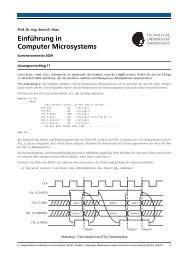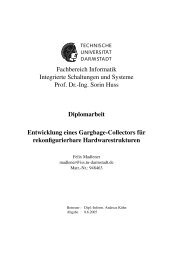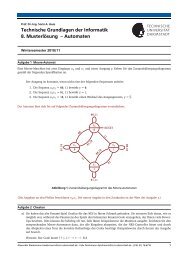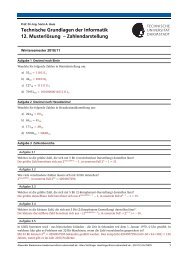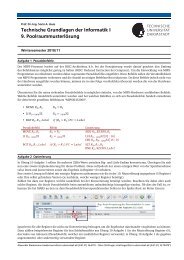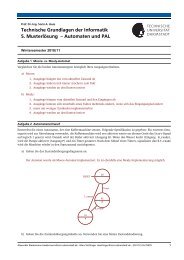FPGA based Hardware Accleration for Elliptic Curve Cryptography ...
FPGA based Hardware Accleration for Elliptic Curve Cryptography ...
FPGA based Hardware Accleration for Elliptic Curve Cryptography ...
Create successful ePaper yourself
Turn your PDF publications into a flip-book with our unique Google optimized e-Paper software.
Ì<br />
Ì<br />
Ì<br />
Ì<br />
Ì<br />
Ì<br />
Ì<br />
Ì<br />
Ì<br />
Ì<br />
Ì<br />
Ì<br />
Ì<br />
Ì<br />
Ì<br />
Ì<br />
2.2. FINITE FIELD ARITHMETIC 12<br />
<strong>Hardware</strong> implementations of the polynomial reduction can especially benefit from hard-coded prime<br />
polynomials with low Hamming weight such as trinomials or pentanomials. Such polynomials are typical<br />
<strong>for</strong> cryptographic and exist <strong>for</strong> all interesting EC parameter sets.<br />
Given a prime trinomial<br />
6 5 )‡59ãä)Oc the reduction process can be per<strong>for</strong>med efficiently by using the<br />
identities:<br />
Ü 5 ã )²c ͉Ï4Ð 5<br />
ª Y Ü 5 㪠Y ),5 Í7Ï4Ð 5<br />
.<br />
This leads to<br />
5 3 Ü 5 㪠) binary XOR operations <strong>for</strong> one polynomial reduction. Reduction of<br />
pentanomials can be per<strong>for</strong>med similar leading to some additional XOR operations. The particular terms<br />
(1...5) of the final equation are structured according to Fig. 2.3 in order to per<strong>for</strong>m the reduction. With<br />
respect to the implementation a single( -bit register is sufficient to store the resulting bit string.<br />
åYºæ<br />
å3 æ<br />
å8 æ<br />
å$Aæ<br />
åèç æ<br />
¢ £h¤ ¥<br />
¢ £¤ ¥<br />
¢ £¤ ¥<br />
¢ £h¤ ¥<br />
¢ £¤ ¥<br />
) = Y ã<br />
) ã Y<br />
) ã Y<br />
) = Y<br />
±ÈÇÉ® Ò ±K5 ±<br />
±ÈÇÉ® Ò ±ª 5 㪠±<br />
±–ÇÉ® Ò 3 = 㪠±5 㪠±<br />
±ÈÇÉ® Ò 3 P 㪠±5 ±<br />
±ÈÇÉ® Ò ª ±K5 ±<br />
n−1 0<br />
(1)<br />
2n−1<br />
2n−b−1 n 2n−1 2n−b<br />
(2) (4)<br />
2n−1<br />
(5)<br />
2n−b<br />
(3)<br />
Result Register (n bit)<br />
Figure 2.3: Structure of the polynomial reduction<br />
n




